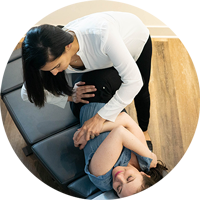Understanding the cause and treatment for overuse injuries like shin splints is key to a successful recovery.
What is a shin splint?
Medically known as medial tibial stress syndrome, shin splints are lower leg pain that is caused by overworking the muscles, tendons and bone tissue. This pain is felt in the tibia one either along the front or sides. Stress fractures can also develop if shin splints aren’t addressed in time. Runners and dancers are at the highest risk for developing shin splints, but cardio-intense athletes like soccer and tennis players can also be plagued by the painful injury.
How do I know I have a shin splint?
The pain caused by shin splints is felt in the lower leg and at it’s most painful when the foot is flexed at the ankle. It’s important to distinguish the pain from two other similarly felt conditions – stress fractures and compartment syndrome The latter condition is characterized by additional muscle weakness and unusual nerve sensations.Typically, shin splint pain is more generalized than that of a stress fracture. Unlike a stress fracture, there is not one exact spot of sharp pain. Shin splints will feel worse in the morning as soft tissue tightens overnight. Stress fractures will feel better in the morning because the bone has rested.
How to prevent a shin splint
Shin splints can develop due to a few preventive measures such as: improper running form, unsupportive shoes, too aggressive of a training schedule, and weak muscles.
The muscles and bones of the lower body can become more prone to injuries because of improper running form. And when combined with unsupportive shoes, it’s a setup for disaster. Wearing shoes with stable arch support can prevent the collapsing of the foot’s arch, and the creation of over pronation.
Another simple way to prevent shin splints is to remember that “slow and steady wins the race.” Don’t try to rush through training. Increasing the intensity of a training program too quickly can cause the muscles to go into shock and send pain up your legs. Be mindful.
Cross training is an important component to add into your workout routine. Cross training is when an athlete trains in another activity in addition to their usual activity. For example, a runner might cross training with weight training on their off run days. Whether you’re training for a long distance race or just running to work, cross training helps to build a strong foundation that can withstand more impact.
How to treat a shin splint
Once shin splints develops, its best to stop all activity and rest, ice and assess. It’s important to combat the inflammation. Wearing orthotics while walking can help to decrease the occurrence of inflammation during the healing process. It’s important to consult with a doctor to determine what range-of-motion exercises are best to keep the leg strong, but also allow it to heal.
At Aligned Modern Health, our Chiropractors in Chicago begin treatment for shin splints with biomechanical assessment to detect any underlying structural issues that may be contributing to the condition. Shin splints can be caused by misalignment that places unnecessary stress on the anterior compartment of the lower leg. Chiropractic adjustments help alleviate pain and can also aid in prevention. We also approach healing for shin splints by strengthening calf and shin muscles with a regime provided by our rehabilitation therapy team.
An alternative medicine approach to using pain medication is to try acupuncture. Aligned Modern Health acupuncturists work with runners in treating a variety of exercise-related injuries to promote healing and reduce pain and swelling. Runners also utilize our Functional Medicine and Clinical Nutrition services help them get their bodies in top condition, regardless of injuries.
If you’re experiencing pain that is keeping you away from the activities you love, don’t hesitate to schedule a complimentary consultation and visit us online to see why we were voted “Best Sports Rehab Center” in the Midwest.









